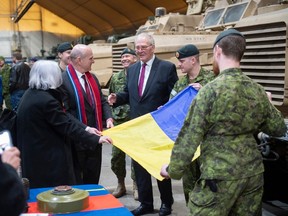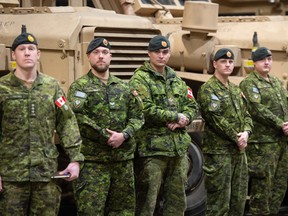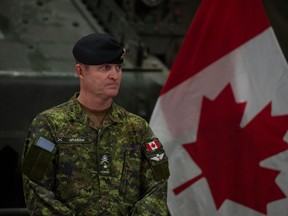“We promised this, (Ukraine) needs it. We want it delivered as quickly as possible”

Article content
The money’s been deposited, the order’s been placed. It’s been more than one year and Canada still hasn’t delivered its promise of a $406-million missile system to help Ukraine in the battle against Russian invaders.
National Defence Minister Bill Blair, in Edmonton this week to announce a $45-million infrastructure project at CFB Edmonton, said the hang-up is stateside.
Advertisement 2
Article content
Article content
Canada committed the money, going in on a contract with the United States, which was already securing the ground-based air defence system NASAMS for the beleaguered Eastern European nation.
But the coalition purchase is in limbo.
“The Americans have to secure the funding in order to finalize the contracts (with manufacturer Kongsberg Defence and Aerospace),” Blair said.
Without the piggybacked deal, it would have taken years to acquire the Norwegian-made national advanced surface-to-air missile system (NASAMS) in the normal procurement process, Blair said.
“We’ve tried to expedite that,” Blair said. “Unfortunately the Americans ran into some challenges in their own funding envelope.”
In January 2023, Ottawa announced the donation of the surface-to-air missile defence system to bolster the Ukraine fight.
“We promised this, (Ukraine) needs it. We want it delivered as quickly as possible,” Blair said.

Billed as the world’s first operational network-centric short- to medium-range ground-based air defence system, the NASAMS can handle multiple simultaneous engagements, with beyond visual range capabilities, expanding the defended area and enhancing the total fighting capability of the armed forces.
Advertisement 3
Article content
No small project, Canada’s gift to Ukraine costs more than the $370 million, earmarked for military infrastructure projects all across Canada over a nine-year window.
Blair said he’s assured all parties understand the project’s importance.
“Certainly the U.S. ambassador has been terrific and advocating on our behalf to his government and I’ve spoken to the secretary of defence’s office. They understand that we feel a strong sense of urgency,” he said.
“(Ukraine) said they want us to continue to proceed with the acquisition of those NASAMS missiles as quickly as possible and we’re doing everything as quickly as possible to make that happen.”
Training Ukraine troops
Blair was in Ukraine last week with Prime Minister Justin Trudeau, and they’ve heard “directly from President (Volodymyr) Zelenskyy,” he said.
He also met with Ukraine’s minister of strategic industry and the minister of defence about Canadian efforts to support them, he said.
Blair praised Edmonton’s Canadian Armed Forces for its involvement in Operation Unifier in collaboration with allies the U.K. and Poland.
Article content
Advertisement 4
Article content
“Your efforts to train over 40,000 Ukrainian troops has been recognized around the world, and is greatly appreciated by the people in Ukraine,” Blair said.

The training to date has occurred in Poland, the U.K. and Latvia. The minister confirmed Canada is considering sending a limited number of personnel to Ukraine under the right conditions — for training missions.
Those conditions haven’t yet been met in Ukraine, Blair said.
“My first concern is to maintain the security of all training personnel,” he said.
“If they are going to undertake training missions, for example, in Ukraine, we have to be under the circumstances in which we would be safe but also very mindful of that Canadian Forces cannot have any combat role or what could be perceived as a combat role.”
How else can we help?
Canada’s acquisition and delivery of 800 drones that Ukraine required will be followed by delivery of requested munitions, Blair said.
Ukraine has asked Canada to deliver surplus CRV-7 rockets that were scheduled for disposal, and Canada is working on complying with the request.
There were initially 83,000 CRV-7 Rocket Scouts acquired in the ’70s and early 1980s and used until 2005, Blair said.
Advertisement 5
Article content
Some have been demolished.
“We do not have the full 83,000, but I believe there are a number of those rockets which are still usable. And there are a number of motors that come with the rockets, which the Ukrainians in my meeting with them last week have indicated that they could use,” Blair said.
“We are doing the work right now to make sure that those munitions can be safely transported. And once that has been determined, and that should be only a matter of days, we will move as quickly as possible to get all of that resource to Ukraine as quickly as possible.”
Training the forces
In the meantime, Canada’s pitching in with training for Ukraine’s soldiers.
Attendees at Monday’s information session included members of Edmonton’s Ukrainian-Canadian community.

They saw the sophisticated metal-detecting equipment Edmonton troops are training Ukrainians to use.
Manoeuvrability, how to breach Russian obstacles on the battlefield, trench systems, minefields — Edmonton know-how is helping Ukrainian boots on the ground acquire and hone vital skills, Capt. Jacques Pecora said Monday.
Advertisement 6
Article content
“There was a defined purpose between us, the Polish and the British, to deliver the skills necessary to keep them safe and effective,” said Pecora, back from a five-month mission to train Ukraine soldiers.
He measures their success in part by intel about graduates who had gone back to Ukraine and occupied a trench vacated by retreating Russian forces.
“They were able to neutralize those explosives and safely occupy those positions. That report really hit home for us and motivated us for the rest of our mission. It meant we were making a difference, it meant we were saving lives,” Pecora said.
Call to double down
Blair said the Liberal government is committed to doubling military spending in the window between 2017 and 2026.
But the 2024 federal budget calls for a reduction in funds allotted to standing military, a member of the media noted.
Time to find more cash, Blair said.
“I’ve asked the Canadian Armed Forces and the Department of National Defence to look at some of our expenditures for things like consultants, things like executive travel and professional services. And I want to be clear, some of those professional services are absolutely essential to the Canadian Armed Forces.
Advertisement 7
Article content
“I think it’s incumbent upon every bureaucracy to look for the most efficient ways to spend those valuable dollars to get the most public value for the Canadian Armed Forces and protection,” Blair said.
Thomas Lukaszuk observed the training in Poland.
The former long-time MLA for Edmonton-Castle Downs, a native of Poland who travels there on business, saw the training mission firsthand.
“The collaboration between Canada and other forces like British forces and training Ukrainians is quite robust and definitely appreciated by Ukraine without a doubt,” Lukaszuk said at Monday’s event.
“But training is one thing. At this point in time Ukraine needs arms. This war is not going to be won on training unarmed soldiers.”

Luzaszuk said Canada and other NATO governments need to double down and step up on military spending.
Currently, Canada is pledged to spend two per cent of its gross domestic product (GDP) on military/defence spending — an increase over previous years that represents a $20-billion budget increase when the country’s running a budget deficit.
“Whether that means cutting back other programs in Canada or increasing taxes, the fact is that we live now in a different world,” Lukaszuk said.
Advertisement 8
Article content
“Our major NATO partner to the south, the United States, is proving itself to be not as predictable as they have been in the past. And our self-reliance and the self-reliance of the remaining NATO partners is becoming much more important than it ever was in the past.”
Edmonton Centre MP Randy Boissonnault, Canada’s minister of employment, workforce development and official languages, said every person on the base was instrumental in putting together Operation Unifier.
“We just had a sombre anniversary — two years into this illegal war, Russia’s invasion of Ukraine trying to upset the international rules-based order that has literally led to prosperity and peaceful times since the Second World War,” Boissonnault said.
“You’ve provided our Ukrainian friends with training, in-take operations, battlefield medicine so that they can defend their country and democracy writ large around the world,” he said.
“The work that you do here is critical on the international stage, as well as for Canadians here at home.”
Recommended from Editorial
Article content





